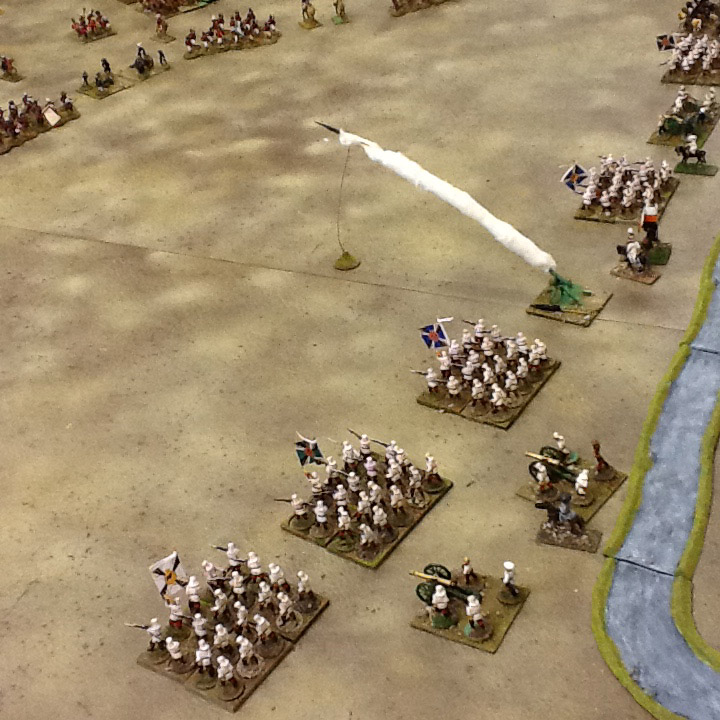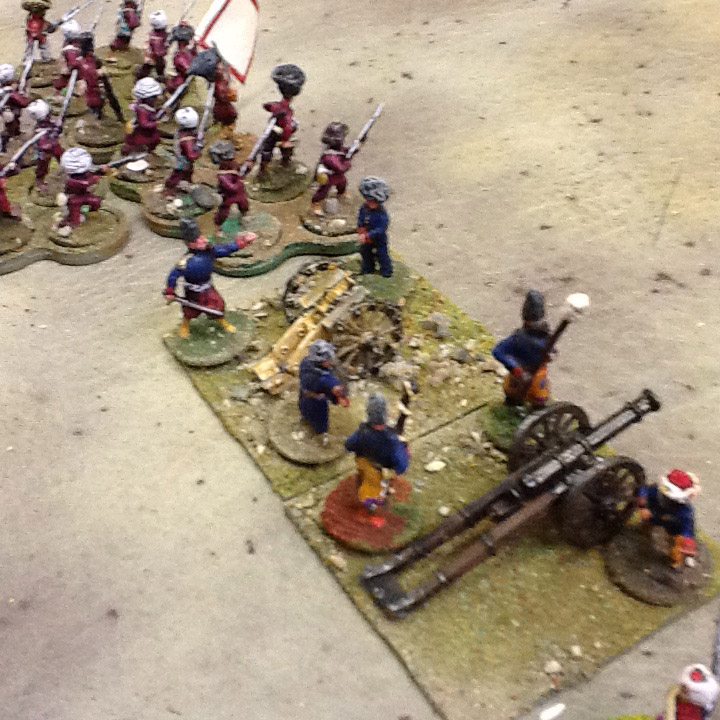by CONRAD CAIRNS- November 2018

A few months ago, that ever-resourceful Yorkshire firm of Irregular Miniatures released a small range of Russian foot and guns for the armies that conquered cental asian khanates between the early1860s and mid 1880s. This was the final piece we needed to game a hitherto-unexploited set of wars, which sound much more intimidating and difficult to set up than is the case.


As ever, we have to start with information. Over the last few decades I have been building up a collection of modern reprints of English-language contemporary works, and when added to the holdings of the Lit and Phil in Newcastle the number of volumes runs into dozens. The one thing the man on the Clapham omnibus probably knows is the existance of Great Game played out between the Russian and British empires through much of the nineteenth century and into the early twentieth, which meant that there was a readership for the accounts by soldiers, journalists, travellers, ethnologists and progagandists of what was going on in the khanates and their eventual fall to the Bear, resulting in an Russian border with Afghanistan, next door to the Empire of India. It is by no means coincidental that the place of publication of some useful tomes was Calcutta. Some were written by clergy (they are not remarkably entertaining), some are very Russophobe, all have their own point of view and (for the reader who lacks Russian) we have a relatively small amount from any of the people directly involved in the fighting. But it is enough.

The Russian army had a very distictive look, and although you can convert American Civil War figures into pretty good versions of the greencoats who had fought for decades in the Caucasus (watch this space), the very light equipment often worn in combat, the havelocks for kepis, the shape of the gimnastikas (baggy shirt-tunics) and the boots rather than shoes all prevent the same process for Central Asia. Cossacks are easily converted from First World War cavalry-the Irregular figure has a drawn shaska, which means the lance has to be added in what looks like an awkward possition, almost vertical behind the right elbow, but is practical, as Cossacks had two leather loops on their spears, one at the butt for this pupose. These Cossacks are from the Orenburg host, and so wear green uniforms, but very likely others had blue. There is a reference to a dragoon unit serving in Central Asia towards the end of the period, but I lack details, and for the moment if the Russians need more mounted trooops they will just have to enlist local irregulars. Sailors were similar to French, but without the red pom-pom on the caps. At least in the ’60s the artillery was brass smooth-bores, so Crimean pieces are fine, and Gatlings (sometomes missleadingly reffered to as mitrailleuses) are easy to buy. The only thing you have to make is the rocket-launcher (Konstantinov system).

The Khanate armies are a bit harder. The main forces were sarbazes, red-uniformed regular infantry (Vereshchagin has three very detailed pictures, showing that some had black facings), and irregular cavalry. Especially with the sarbazes, most states seem to have had troops of very similar appearance. The most obvious cultural signifier was the headgear, but as the peoples of the area often served in armies other than those of any nominal homeland, I’ve not been too dogmatic. The Bukharan army can have Perians, Kirghiz etc. in its ranks. I made the infantry from numerous figuers left over from the 1970s to now, replacing shakoes Carlist berets, kepis,sun-helmets by Miliput turbans, fur hats, strange Kazakh and Kirghiz milinary . Irregular Miniatures Persians make spitting images of some tarbazes illustrated in the 1840s. The cavalry and irregular infantry can be nineteenth-century Bashkirs, Afghans or Persians, or medieval. Gripping Beast plastic Arab Light Horse are excellent, except for the bows-the people here used recurved composite weapons in the Sino-Mongolian style, much longer than the Indo-Persian-Turkic weapons most wargame figures wield. The solution is easy-those relatively few warriors still using archery now have 42 mm scale bow cases. More importantly, most long arms were equipped with a very distinctive A or V shaped bipod, sometimes long enough to rest a weapon shot from a sitting or kneeling possition, and these have to be added with florist’s wire. Some Central Asians have very dark skins, so we can bulk out the irregulars with some musketeers and cavalry from the Lake Chad area, although the majority of my West African troops wore garments rather different from anything apparent in the khanates.

Vereshchagin did some marvellous studies of dervishes, camels, yaks, a falcolner, and all of these are now rendered in 28mm, as is his row of notables inspecting a pile of severed heads. The dervish can have long exchanges on spiritual matters including the value of icons with the two Orthodox priests. There are plenty of colourful real-life generals and warlords, not forgetting count Nikolay Ignatyev (1832-1908). Fictional characters include Harry Flashman and Boris Akunin’s nun detective, Sister Pelagia, and Dr John Watson (Northumberland Fusiliers). The last can appear in games which pit the Russians against the forces of one (or all three) of the powers which they might have fought, Britain, Persia and China. Mosques in Kashgar looked like Chinese temples, with pagodas as minarets. The Russians had a flotillas of ships on Lake Baikal, including stern-wheelers built in Liverpool.

Durham Wargames Group is lucky to possess many useful builimgs. Some cities had huge mud walls and towers,and we have shown a stylised innner citadel with the outer walls in a derelict state. Samarkand is a World Heritage Site, and rather than try to replicate any of the famous monuments it seems better to use what we have as generic structures, based on nineteenth-century paintings and photograpghs. We recently did a game set in late twentieth-century Somalia, and after ediiting out those structures which would be hard or impossible to build with mud bricks, and convering up adverts for Coca-Cola with Blu-tacked carpets etc, we have all we need.

What campaign to start with? We decided on the 1866-1868 conquest of the Khanate of Bukhara for several reasons. The Russians used rifled muskets and smooth-bore artillery, and the Khanate men mainly smooth-bore matchlocks and some flintlocks, with a varied collection of smooth-bore guns, so we need not worry about when the Russians (and a few Asian troops) got breech-loaers and rifled artillery. It involved several field actions, in an area whwre much of the fighting consisted of the attack and defence of forts and cities. We have coloured contemporary maps of Samarkand and of the final battle of the war, Zerabulak (other spellings are found for all place-names), on 2nd June1868 (Old Style), which took place when the main Russian force under Konstantin von Kaufman (1818-1882) sallied out of the recently-taken Samarkand and hit with no little vim a very large Bukharan army just short of the city of Kattakurgan upon the banks of the river Zarafshan. Kaufman had left a small garrison in Samarkand, which was at the same time attacked by enemy who outnumbered it dozens to one, so by telescoping distance of about 70-90 versts/kilometres we can present two actions on the same table. Split-screen wargaming! What (as the Japanese say) could possibly be more satisfactory?


SOURCES
Printed
As noted above, a full bibliography would be impossble here. There is a very good one in the one essential recent book, Ian Heath, Amies of the Nineteenth Century: Asia, vol 1: Central Asia and the Himalayan Kingdoms, Nottingham, 1998.
Of earlier works, the job of selecting a few is invidious but here they are:
[an Indian Officer] Russia’s March towards India, 2 vols, London, 1894, reprinted Elibron, 2006.James Hutton, Central Asia from the Aryan to the Cossack, London, 1875, reprinted Pallas Armata 1998.
Charles Marvin, The Disasterous Russian Campaign against the Akhal Tekke Turcomans, London, 1880, reprinted Pallas Armata,1997.
Januarius Aloysius MacGahan, Campaigning on the Oxus and the Fall of Khiva, New York, 1874, reprinted Elibron, 2005.
Eugene Schuyler, Turkestan, 2 vols, London, 1876, reprited Elibron, 2005.
Online
Numerous, but three outstanding areas to search:
The Library of Congress, Washington DC, has digitallised the Turkestan Album, a luxury work produced in 1871-2 for Kaufman, which has well over a thousand photographs other works, including coloured maps. The captions are in English.
We are very lucky that one of the great artists of the age served as a soldier and then produced prolific studies of the wars and the area. MacGahan’s and Schuyler’s books both contain illustraions by Vasily Vereshchagin (1842-1904), and his oils are available by going onto the Wikipaedia entry, then following the Wikicommons link.
More of a conventional battle-painter was Nikolai Karazin (1842-1908), and his works are often later than the events he depicts, but he has masses of ethnographic and military detail.
Film
As this set of wars overlapped almost exactly with the US’s conflicts with the Native Americans of the Great Plains and South-West, but with everyyhing far bigger, bloodier and more spectacular, there realy ought to have been a Russian John Ford. As yet I’ve found nothing. The dictatorship of Khazakhstan has produced two features, both set in the eighteenth century, but which show a lot of the material culture which would still be relavent: Myn Bala/Warriors of the Steppe (2011) and Nomad (2005).
Music
Both sides seem to have used bands. I’ve reconstructed one for the tarbazes, and am looking for recordings of the music. The Russians bands would be more difficult, but no matter-Russian regiments had choirs, and at the command singers to the front made a wonderful sound while on the move. The Soglasie Male Voice Choir of St Petersburg give a splendid rendition of traditional music. The Russians did storm cities to the the National Hymn, and the first bit of the title of this article quotes to what I believed for years to be its opening words (they’re not, but they should be).
Orders of Battle
Russians at Zerabulak: 18 companies of infantry, 6 sotnias of Cossacks, 4 guns-perhaps 4,500 in all.
Russians in Samarkand under Major von Stempel: 685 men, many sick, and captured Bukharan guns.
Bukharans at Zerabulak: 6,000 foot, 15,000 horse, 15 light guns (estimate- may well be too high). Bukharans around Samarkand: 15,000 townsmen, 15,000 Kazakhs, 25,000 militia (estimate).
Finally, thanks to Paul Mooney, wargamer of Merseyside, for commissioning the Russian troops and starting all this.
